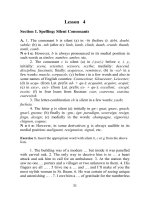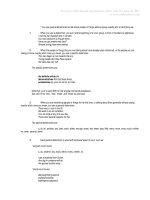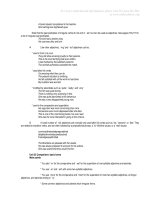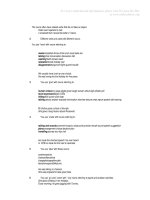Tài liệu Collins cobuild student grammar part 4 pdf
Bạn đang xem bản rút gọn của tài liệu. Xem và tải ngay bản đầy đủ của tài liệu tại đây (49.57 KB, 15 trang )
For more material and information, please visit Tai Lieu Du Hoc
at www.tailieuduhoc.org
A bored student complained to his teacher.
She had big blue frightened eyes.
Note that the past participles of irregular verbs do not end in `-ed', but can be used as adjectives. See pages 216-217 for
a list of irregular past participles.
The bird had a broken wing.
His coat was dirty and torn.
4 Like other adjectives, `-ing' and `-ed' adjectives can be:
* used in front of a noun
They still show amazing loyalty to their parents.
This is the most terrifying tale ever written.
I was thanked by the satisfied customer.
The worried authorities cancelled the match.
* used after link verbs
It's amazing what they can do.
The present situation is terrifying.
He felt satisfied with all the work he had done.
My husband was worried.
* modified by adverbials such as `quite', `really', and `very'
The film was quite boring.
There is nothing very surprising in this.
She was quite astonished at his behaviour.
He was a very disappointed young man.
* used in the comparative and superlative
His argument was more convincing than mine.
He became even more depressed after she died.
This is one of the most boring books I've ever read.
She was the most interested in going to the cinema.
5 A small number of `-ed' adjectives are normally only used after link verbs such as `be', `become', or `feel'. They
are related to transitive verbs, and are often followed by a prepositional phrase, a `to'-infinitive clause, or a `that'-clause.
convincedinterestedpreparedtired
delightedinvolvedscaredtouched
finishedpleasedthrilled
The Brazilians are pleased with the results.
He was always prepared to account for his actions.
She was scared that they would find her.
Unit 35 Comparison: basic forms
Main points
* You add `-er' for the comparative and `-est' for the superlative of one-syllable adjectives and adverbs.
* You use `-er' and `-est' with some two-syllable adjectives.
* You use `more' for the comparative and `most' for the superlative of most two-syllable adjectives, all longer
adjectives, and adverbs ending in `-ly'.
* Some common adjectives and adverbs have irregular forms.
For more material and information, please visit Tai Lieu Du Hoc
at www.tailieuduhoc.org
1 You add `-er' for the comparative form and `-est' for the superlative form of one-syllable adjectives and adverbs.
If they end in `-e', you add `-r' and `-st'.
cheap* cheaper* cheapest
safe* safer* safest
closecoldfasthardlargelightnice
poorquickroughsmallweakwideyoung
They worked harder.
I've found a nicer hotel.
If they end in a single vowel and consonant (except `-w'), double the consonant.
big* bigger* biggest
fathotsadthinwet
The day grew hotter.
Henry was the biggest of them.
2 With two-syllable adjectives and adverbs ending in a consonant and `-y', you change the `-y' to `-i' and add `-er'
and `-est'.
happy* happier* happiest
angrybusydirtyeasyfriendly
funnyheavyluckysillytiny
It couldn't be easier.
That is the funniest bit of the film.
3 You use `more' for the comparative and `most' for the superlative of most two-syllable adjectives, all longer
adjectives, and adverbs ending in `-ly'.
careful* more careful* most careful
beautiful* more beautiful* most beautiful
seriously* more seriously* most seriously
Be more careful next time.
They are the most beautiful gardens in the world.
It affected Clive most seriously.
Note that for `early' as an adjective or adverb, you use `earlier' and `earliest', not `more' and `most'.
4 With some common two-syllable adjectives and adverbs you can either add `-er' and `-est', or use `more' and
`most'.
commongentlelikelypleasantsimple
cruelhandsomenarrowpolitestupid
For more material and information, please visit Tai Lieu Du Hoc
at www.tailieuduhoc.org
Note that `clever' and `quiet' only add `-er' and `-est'.
It was quieter outside.
He was the cleverest man I ever knew.
5 You normally use `the' with superlative adjectives in front of a noun, but you can omit `the' after a link verb.
It was the happiest day of my life.
I was happiest when I was on my own.
WARNING: When `most' is used without `the' in front of adjectives and adverbs, it often means almost the same as
`very'.
This book was most interesting.
I object most strongly.
6 A few common adjectives and adverbs have irregular comparative and superlative forms.
good/well* better* best
bad/badly* worse* worst
far* farther/further* farthest/furthest
old* older/elder* oldest/eldest
She would ask him when she knew him better.
She sat near the furthest window.
Note that you use `elder' or `eldest' to say which brother, sister, or child in a family you mean.
Our eldest daughter couldn't come.
Unit 36 Comparison: uses
Main points
* Comparative adjectives are used to compare people or things.
* Superlative adjectives are used to say that one person or thing has more of a quality than others in a group or
others of that kind.
* Comparative adverbs are used in the same way as adjectives.
1 You use comparative adjectives to compare one person or thing with another, or with the same person or thing
at another time. After a comparative adjective, you often use `than'.
She was much older than me.
I am happier than I have ever been.
2 You use a superlative to say that one person or thing has more of a quality than others in a group or others of
that kind.
Tokyo is Japan's largest city.
He was the tallest person there.
Buses are often the cheapest way of travelling.
3 You can use comparative and superlative adjectives in front of a noun.
I was a better writer than he was.
He had more important things to do.
It was the quickest route from Rome to Naples.
You can also use comparative and superlative adjectives after link verbs.
My brother is younger than me.
He feels more content now.
For more material and information, please visit Tai Lieu Du Hoc
at www.tailieuduhoc.org
The sergeant was the tallest.
This book was the most interesting.
4 You can use adverbs of degree in front of comparative adjectives.
a bit, far, a great/good deal, a little, a lot, much, rather, slightly
This car's a bit more expensive.
Now I feel a great deal more confident.
It's a rather more complicated story than that.
You can also use adverbs of degree such as `by far', `easily', `much', or `quite' in front of `the' and superlative adjectives.
It was by far the worst hospital I had ever seen.
She was easily the most intelligent person in the class.
Note that you can put `very' between `the' and a superlative adjective ending in `-est'.
It was of the very highest quality.
5 When you want to say that one situation depends on another, you can use `the' and a comparative followed by
`the' and another comparative.
The smaller it is, the cheaper it is to post.
The larger the organisation is, the greater the problem of administration becomes.
When you want to say that something increases or decreases, you can use two comparatives linked by `and'.
It's getting harder and harder to find a job.
Cars are becoming more and more expensive.
6 After a superlative adjective, you can use a prepositional phrase to specify the group you are talking about.
Henry was the biggest of them.
These cakes are probably the best in the world.
He was the most dangerous man in the country.
7 You use the same structures in comparisons using adverbs as those given for adjectives:
* `than' after comparative adverbs
Prices have been rising faster than incomes.
* `the' and a comparative adverb followed by `the' and another comparative adverb
The quicker we finish, the sooner we will go home.
* two comparative adverbs linked by `and'
He sounded worse and worse.
He drove faster and faster till we told him to stop.
Unit 37 Other ways of comparing
Main points
* This includes words like: `as...as', `the same (as)' and `like'.
* You use `as...as...' to compare people or things.
* You can also compare people or things by using `the same (as)'.
* You can also compare people or things by using a link verb and a phrase beginning with `like'.
For more material and information, please visit Tai Lieu Du Hoc
at www.tailieuduhoc.org
1 You use `as...as...' to compare people or things that are similar in some way.You use `as' and an adjective or
adverb, followed by `as' and a noun group, an adverbial, or a clause.
You're as bad as your sister.
The airport was as crowded as ever.
I am as good as she is.
Let us examine it as carefully as we can.
2 You can make a negative comparison using `not as...as...' or `not so...as...'.
The food wasn't as good as yesterday.
They are not as clever as they appear to be.
He is not so old as I thought.
3 You can use the adverbs `almost', `just', `nearly', or `quite' in front of `as...as...'.
He was almost as fast as his brother.
Mary was just as pale as before.
She was nearly as tall as he was.
In a negative comparison, you can use `not nearly' or `not quite' before `as...as...'.
This is not nearly as complicated as it sounds.
The hotel was not quite as good as they expected.
4 When you want to say that one thing is very similar to something else, you can use `the same as' followed by a
noun group, an adverbial, or a clause.
Your bag is the same as mine.
I said the same as always.
She looked the same as she did yesterday.
If people or things are very similar or identical, you can also say that they are `the same'.
Teenage fashions are the same all over the world.
The initial stage of learning English is the same for many students.
You can use some adverbs in front of `the same as' or `the same'.
almostjustmuchroughly
exactlymore or lessnearlyvirtually
He did exactly the same as John did.
You two look almost the same.
You can use `the same' in front of a noun group, with or without `as' after the noun group.
They reached almost the same height.
It was painted the same colour as the wall.
5 You can also compare people or things by using a link verb such as `be', `feel', `look', or `seem' and a phrase
beginning with `like'.
It was like a dream.
He still feels like a child.
He looked like an actor.
The houses seemed like mansions.
You can use some adverbs in front of `like'.
a bit, a little, exactly, just, least, less, more, most, quite, rather, somewhat, very
He looks just like a baby.
Of all his children, she was the one most like me.
For more material and information, please visit Tai Lieu Du Hoc
at www.tailieuduhoc.org
6 If the noun group after `as' or `like' in any of these structures is a pronoun, you use an object pronoun or
possessive pronoun.
Jane was as clever as him.
His car is the same as mine.
7 You can also use `less' and `least' to make comparisons with the opposite meaning to `more' and `most'.
They were less fortunate than us.
He was the least skilled of the workers.
We see him less frequently than we used to.
Unit 38 Adverbials
Main points
* Adverbials are usually adverbs, adverb phrases, or prepositional phrases.
* Adverbials of manner, place, and time are used to say how, where, or when something happens.
* Adverbials usually come after the verb, or after the object if there is one.
* The usual order of adverbials is manner, then place, then time.
1 An adverbial is often one word, an adverb.
Sit there quietly, and listen to this music.
However, an adverbial can also be a group of words:
* an adverb phrase
He did not play well enough to win.
* a prepositional phrase
The children were playing in the park.
* a noun group, usually a time expression
Come and see me next week.
2 You use an adverbial of manner to describe the way in which something happens or is done.
They looked anxiously at each other.
She listened with great patience as he told his story.
You use an adverbial of place to say where something happens.
A plane flew overhead.
No birds or animals came near the body.
You use an adverbial of time to say when something happens.
She will be here soon.
He was born on 3 April 1925.
3 You normally put adverbials of manner, place, and time after the main verb.
She sang beautifully.
The book was lying on the table.
The car broke down yesterday.
If the verb has an object, you put the adverbial after the object.
I did learn to play a few tunes very badly.
Thomas made his decision immediately.









